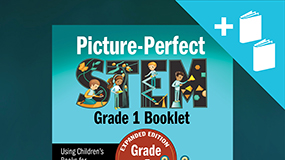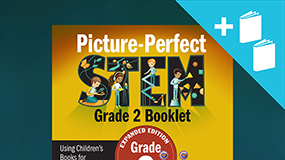Picture-Perfect STEM Lesson Plans
Children's Book Packs
By: Karen Ansberry & Emily Morgan
Authors of the Award Winning NSTA Press Picture-Perfect STEM Series
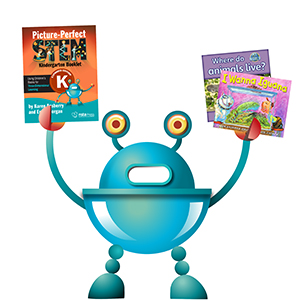
Engage children in reading and science through lessons & picture books
Picture-Perfect Science Lessons delivers the whole package:
Browse By Grade Level
Pick and choose which lessons fit best into your curriculum
K
Kindergarten Book Packs
Each pack includes a custom printed Lesson Booklet & 2 accompanying Picture Books
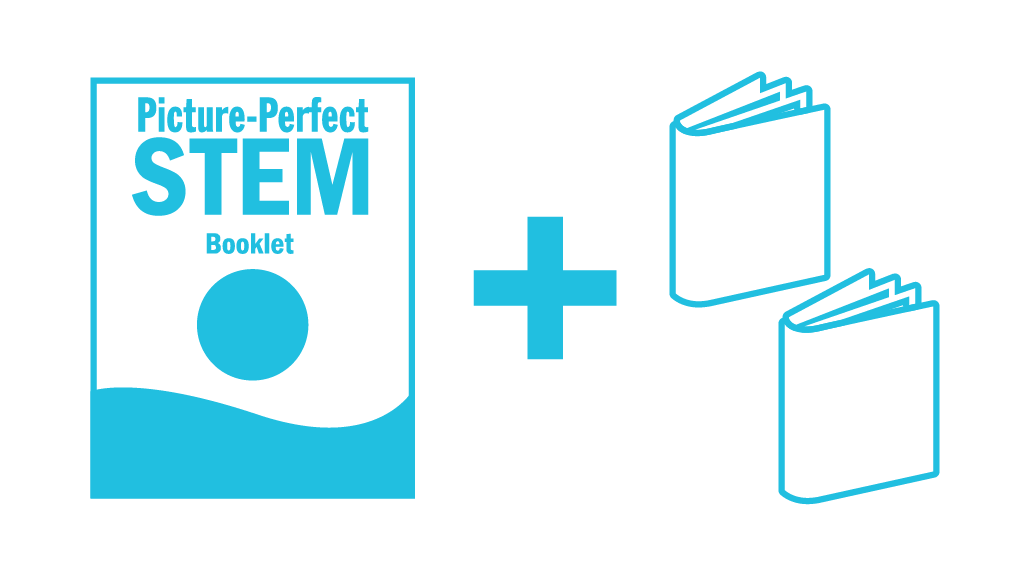
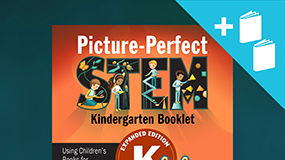
Animal Architects
Students explore the phenomenon of squirrels changing their environment to meet their needs by burying seeds. They add to their understanding by reading a nonfiction book and watching videos to learn how other animals, such as gopher tortoises and beavers, engineer structures that affect their environment. They are then challenged to create a paper collage to illustrate the idea that animals can change their environment to meet their needs.
- Squirrels Leap, Squirrels Sleep
- We Build Our Homes

Be a Friend to Trees
Learners explore the phenomenon that many things they use every day come from trees. They learn the importance of trees as sources of food, shelter, and oxygen for people and animals, and ways to conserve trees.
- Be a Friend to Trees
- Our Tree Named Steve

Design a Habitat
After reading a picture book about a boy who is begging his mom for a pet iguana, students explore the phenomenon of different kinds of animals living in different places on Earth. They learn about the needs of living things and the diverse habitats that meet those needs. Engineering design comes into play when students apply their knowledge about the needs of animals by designing and building a model habitat for an imaginary pet of their own.
- I Wanna Iguana
- Where Do Animals Live?

Do You Know Which Ones Will Grow?
Learners explore the phenomenon that some things grow (like people, cats, and snakes) and other things do not grow (like chairs, hats, and cakes). They learn the difference between living and nonliving things and what living things need to survive.
- Do You Know Which Ones Will Grow?
- What’s Alive?

Feel the Heat
Students explore the phenomenon of temperature difference between sun and shade on a surface on the school grounds. They carry out an investigation of temperatures of surfaces around their school in the sun and in the shade to see if shady surfaces are cooler than surfaces that are in the sun. Then, they design, build, and test physical models of shade structures that could provide a place to stay cool on the playground.
- Summer Sun Risin’
- Sun and Shade

Move It!
Students explore the phenomena of a toy car on a ramp speeding up, slowing down, and stopping. They read a nonfiction book about forces and explore how pushes and pulls can change motion. Then, they apply their knowledge to complete a design challenge: getting a toy dog (named Newton) into his doghouse!
- Move It! Motion, Forces and You
- Newton and Me

Soccer Science
Students explore the phenomenon of how soccer players get a soccer ball to go where they want it to go. They read a nonfiction book about motion and observe and describe patterns of forces and motion (e.g., the harder you kick, the faster the ball goes). Then, they apply their understandings about forces and motion to design a game that uses pushes and pulls.
- Little Soccer
- Oscar and the Cricket: A Book About Moving and Rolling

Sunshine on My Shoulders
Learners observe the phenomenon of “mystery bead” bracelets changing colors when they go outdoors and conduct simple investigations to find out what makes the beads change color. They discover that invisible rays of ultraviolet (UV) light cause the beads to change color. They learn about the benefits of the Sun, as well as the harmful effects of too much sunlight on their skin, and they test the effectiveness of sunscreen on UV beads. Finally, learners create a sun safety poster.
- Sunshine on My Shoulders
- Sun

The Handiest Things
Students explore the idea that a variety of technologies—from chopsticks to calculators—solve problems in our everyday lives. They learn that all technologies have various parts that work together to solve a problem, and then they brainstorm some new parts to improve an invention they use every day—a backpack.
- The Handiest Things in the World
- Engineering in Our Everyday Lives

The Perfect Day for a Picnic
Learners explore the phenomenon of weather changing throughout a week (and even throughout a day), beginning with a funny read-aloud about a picnic that unexpectedly gets rained out. They keep track of weather conditions in their area for a week in order to look for patterns. Then, they read a nonfiction book and watch a video about the importance of weather forecasting, especially in severe weather. They apply their understandings by viewing a local weather forecast and discussing how they can prepare for the upcoming weather. Finally, they read a fictional forecast and apply their understandings to decide which day would be the “perfect day for a picnic!”
- Pignic
- Weather Near You



